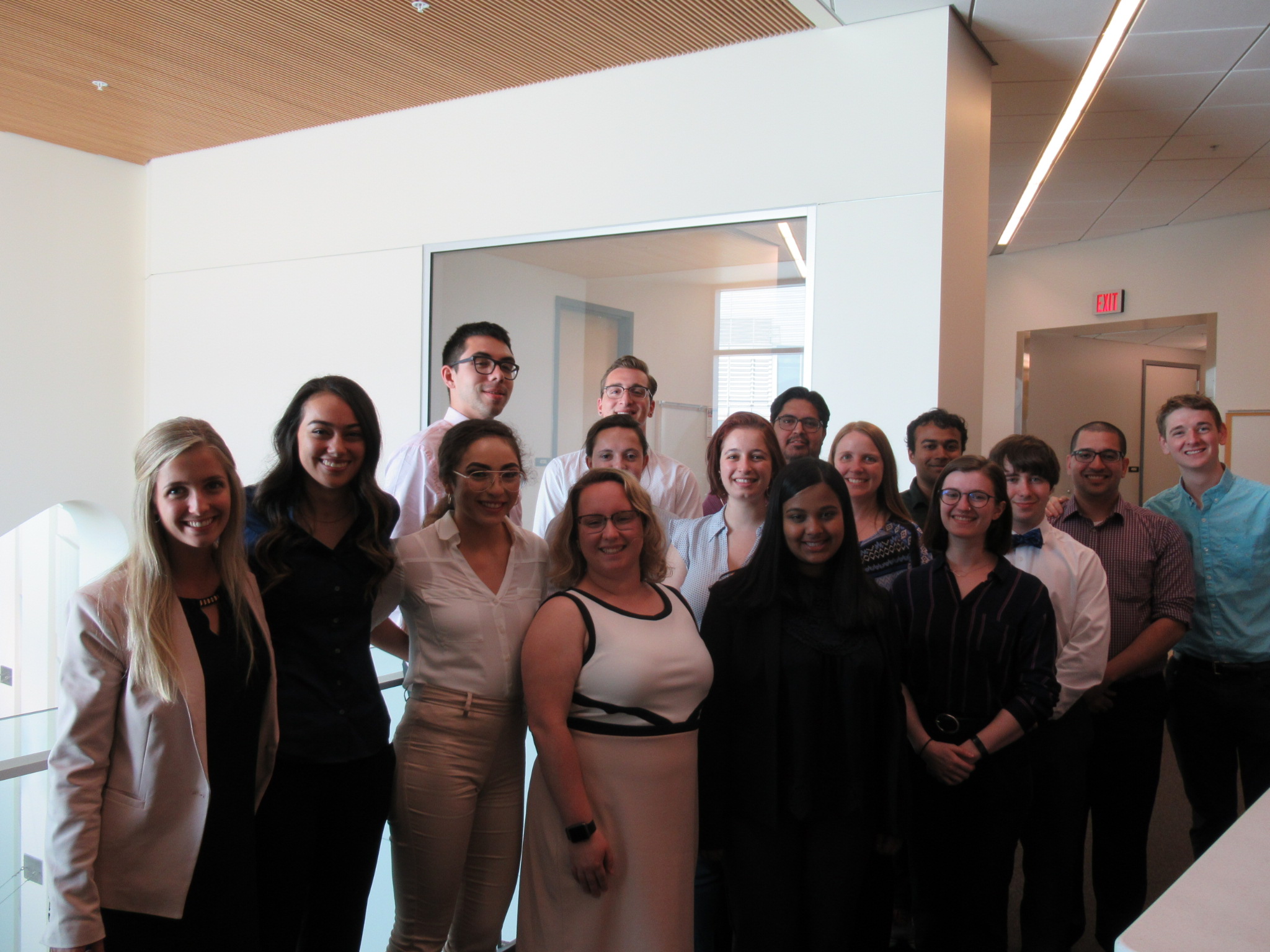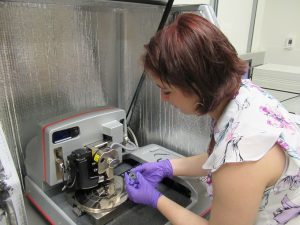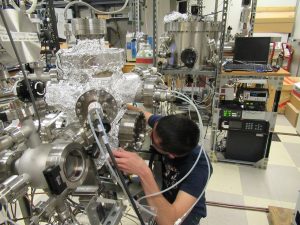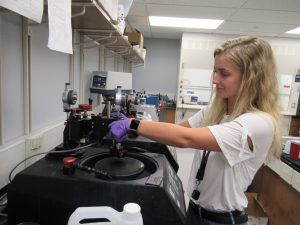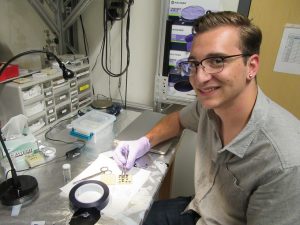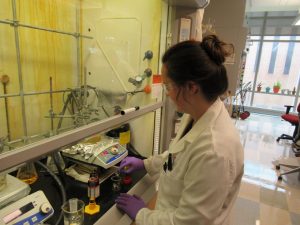Summer Research Experience for Undergraduates 2019
2019 Summer REU Student Information & Research Abstracts
Undergraduate Institution: New Mexico Highlands University
Major: Biochemistry
REU Advisor: Dr. Jessica Winter
Project Title: In Vitro Development of Super Paramagnetic Iron Oxide Nanoparticles as Contrast Agents for Magnetic Resonance Imaging
Abstract: “The expansion in human understanding of inorganic nanoparticles effective superstructures allows for considerable advancement in various disciplines. The unique nanoparticle properties expressed by superparamagnetic iron oxide nanoparticles (SPIONs) support many practical implications, including electronic development and medical amelioration. In particular, the formulation of superior contrast agents can greatly enhance the quality of magnetic resonance imaging (MRI). Currently the most common contrast agents are gadolinium-based reactants, shown to produce a considerable amount of toxicity. These superstructures contain a single magnetic domain that flips between opposing magnetic states with a very small energy barrier, allowing these particles to construct in such a manner that exhibits randomized fluctuating magnetization. Utilizing the interfacial instability method, we synthesized SPION loaded aggregates where successful formation was characterized by transmission electron microscopy (TEM). Different types of SPION loaded aggregates were then tested as MRI contrast agents.”
Undergraduate Institution: University of New Hampshire
Major: Chemical Engineering
REU Advisor: Dr. Jay Gupta
Project Title: Polymer-Free Transfer of 2D Materials onto III-V Semiconductor Surfaces for Scanning Probe Microscopy and Molecule-Encapsulation Experiments
Abstract: “Two-dimensional (2D) materials show great promise for a large variety of applications due to their unique electronic and physical properties. Stacking different 2D materials in a particular order creates new structures with properties that can be used to assemble the next generation of electronic devices.
In this project, a tabletop dry touch-transfer method employing van der Waals forces was used to transfer multi to few-layer flakes of hexagonal boron nitride (hBN) and graphite onto cleaved, atomically flat GaAs (110) and InSb (110) semiconducting surfaces. This method offers a cleaner alternative to current polymer-involved transfer methods, which leave polymer traces on the sample surface and require an extensive cleaning process for scanning probe microscopy (SPM) study.
An attractive application of this touch-transfer method is the encapsulation of target molecules between the semiconductor surface and graphene flakes for scanning tunneling microscopy (STM) studies. The conductivity of graphene allows us to probe the electronic states of otherwise challenging molecules and explore their possible applications. We present the results of encapsulation of deionized water droplets between GaAs (110) and thinned graphite, characterized by atomic force (AFM), scanning electron (SEM) and optical microscopy techniques. Further studies will utilize nano-squeegeeing techniques using contact-mode AFM to control the placement of trapped water molecules.”
Undergraduate Institution: New Mexico Highlands University
Major: Chemistry
REU Advisor: Dr. Vicky Doan-Nguyen
Project Title: Exploration of Rapid Synthesis Techniques for Smart Windows Application
Abstract: “Thermochromic vanadium dioxide (VO2) nanoparticles are extensively studied due to their wide range of electrical and optical properties. The monoclinic phase of VO2, P21/c, undergoes a first order reversible metal-to-insulator transition (MIT) near room temperature, 68 °C, which is advantageous for smart windows applications. Above the transition temperature, VO2 is metallic with a tetragonal rutile structure (P42/mnm), which allows thin monoclinic phase (P21/c) which is translucent to the near-infrared, making VO2 a promising material for smart windows application1,2. However, preparation of monoclinic VO2 requires long reaction times, high temperatures, and various possible polymorphs may form which presents a challenge in achieving phase purity2. Furthermore, through doping the system with transition metals the MIT linearly decreases to below room temperature, enabling the use of this compound for smart windows at various operating temperatures3. Scandium is one such transition metal that when coated on a surface, creates a transparent thin film not displayed by other dopants. Various synthetic approaches have been published controlling the particle size and morphology of these nanoparticles to tune the properties2,4,5. In this study, multiple synthetic approaches including hydrothermal, solid state, microwave, and seeding techniques are developed to create a rapid procedure to phase pure monoclinic VO2 with high morphological tenability for smart windows application. The elemental composition was characterized by powder X-ray diffraction (XRD) and Rietveld analysis. The morphology, and crystallinity of the nanoparticles was determined using scanning electron microscopy (SEM).”
Undergraduate Institution: University of Georgia
Major: Chemistry
REU Advisor: Dr. Robert Baker
Project Title: Electrochemical Reduction of CO2 Through Au/Cu Catalysis
Abstract: “Carbon dioxide emissions and other forms of pollution pose a significant threat to the environment. In recent years, more research has been conducted into converting these emissions into a renewable energy source. One method for this process is the electrochemical reduction of carbon dioxide. Here, we report on the results of using different ratios of Au/Cu nanoparticles under different electric potentials for the CO2 reduction reaction. Nanoparticles were used after determining they were more selective for CO product formation than H2 product formation. The major products from this reaction are carbon monoxide and hydrogen gas. Catalysts with higher ratios of Au produced more carbon monoxide, while catalysts with higher ratios of Cu produced more hydrogen gas. Formate was also detected on all catalysts containing copper. The concentration of formate decreased as the copper content in the catalysts increased.”
Undergraduate Institution: University of Texas at Dallas
Major: Physics
REU Advisor: Dr. Rolando Valdes Aguilar
Project Title: High Bandwidth THz Emission of Magnetic Heterostructures
Abstract: “THz electromagnetic waves have photon energies around the meV range and hence interact strongly with compounds that have electron transitions in this range. As a result, terahertz (THz) spectroscopy has been a useful tool in characterizing these compounds based on their interactions with THz electromagnetic radiation. We verify the properties of two previously reported THz emitters via THz emission spectroscopy as well as determine the sensitivity of our own spectroscopic instruments. We examine the impact ambient as well as systematic effects have on optimizing the bandwidth of THz emission spectroscopy with these emitters.”
Undergraduate Institution: University of Texas at San Antonio
Major: Physics
REU Advisor: Dr. Fengyuan Yang
Project Title: Preparation and Characterization of Novel Skyrmion Heterostructures
Abstract: “Magnetic skyrmions are local swirls of magnetization in a magnetic material and are characterized by a unique topology known as the winding number. Skyrmions hold promise for the next generation of information storage devices because: (1) they can be as small as 1 nm in diameter, allowing for ultra-high information densities; (2) consume less energy to create/destroy a bit; and (3), and can be manipulated to speeds exceeding that of conventional magnetic-domain based architectures. Here, we explore a novel mechanism for the stabilization of skyrmions in bilayer systems of insulating anti- ferromagnetic (AF) NiO and conducting ferromagnetic (FM) SrRuO3 bilayers. We report on the preparation and characterization of NiO/SrRuO3 bilayer thin films. These films were grown on treated SrTiO3(001) substrates via ultra-high vacuum off-axis sputtering. Films were characterized through a combination of X-ray diffraction (XRD), X-ray reflectometry (XRR), atomic force microscopy (AFM), SQUID magnetometry, and magneto-transport. Electrical transport measurements hint at signatures of topological magnetic phases like skyrmions. These initial measurements are promising for stabilizing novel topological magnetic phases in AF/FM bilayers.”
Undergraduate Institution: Mercyhurst University
Major: Chemistry
REU Advisor: Dr. Roberto Myers
Project Title: Epitaxial growth and characterization of β-Ga2O3/µ-Fe2O3 superlattices on (010) β-Ga2O3substrates
Abstract: “This paper demonstrates the growth study of β-Ga2O3 and µ-Fe2O3 superlattices on (010) β-Ga2O3 substrates. The successful synthesis of µ-Fe2O3 has a strong potential to replace SiC and GaN in high power electronics and integrate magnetism into this industry. This superlattice was grown using Plasma-Assisted (PA) Molecular Beam Epitaxy (MBE) and analyzed with Atomic Force Microscopy (AFM) for surface roughness measurements, X-ray Diffraction (XRD) to confirm the lattice matching, and Superconducting Quantum Interference Device (SQUID) for magnetic properties. One of the project’s goals is to find the optimal flux and temperature parameters that produce a smooth surface. So far, the smoothest surface achieved had an RMS roughness of 0.474 nm and was grown at a beam flux equivalent of Torr for gallium and Torr for iron sources while the substrate temperature during growth was 700°C.”
Undergraduate Institution: Columbus State Community College
Major: Materials Science Engineering
REU Advisor: Dr. David McComb
Project Title: Utilizing Electron Energy Loss Spectroscopy (EELS) for Polymer Analysis
Abstract: “The functional groups in organic polymers have been widely studied using X-ray Absorption Near Edge Structure (XANES) Spectroscopy. The fine structure of the carbon K-edge is a unique spectroscopic fingerprint and can be assigned to specific chemical functional groups. Similar to XANES, Electron Energy-Loss Spectroscopy (EELS) can provide equivalent information with the possibility of better spatial resolution. EELS is powerful characterization tool for distinguishing organic polymers due to its sensitivity and ability to identify chemical structures on a nanometer scale. The advancements in direct electron detection, monochromation, and electron sources have made EELS a promising alternative for chemical structure analysis, providing a better energy and spatial resolution. EELS also has the capability to perform experiments at cryogenic temperatures, thereby minimizing beam damage. In this study we report carbon K-edge EELS data from three common polymers: poly (ether ether ketone) (PEEK), polycarbonate (PC), and polystyrene (PS) at room and cryogenic temperatures. These spectra illustrate the sensitivity of EELS on organic polymer functional groups. This data will then be used as a reference to characterize unknown biological samples or polymer blends.”
Undergraduate Institution: Columbia University
Major: Physics and Mathematics
REU Advisor: Dr. Nandini Trivedi
Project Title: Magnetic Behavior of Monolayer CrI³ in the J-K-Γ Model
Abstract: “Monolayer CrI³ is notable for demonstrating magnetic order in a 2- dimensional system, suggesting an underlying magnetic anisotropy. We use mean field theory to model the system as a Kitaev ferromagnet, and crystal symmetry to consider an additional coupling, the symmetric off-diagonal (Γ) interaction. Using linear and nonlinear spin wave theory, we develop calculations for the magnon dispersion, and subsequently calculate the magnetization and the magnetic susceptibility at finite temperature. We evaluate the effects of each coupling and compare in the context of experiments on CrI³, and subsequently consider the capabilities and limitations of mean field theory and spin wave theory.”
Undergraduate Institution: Case Western Reserve University
Major: Engineering Physics, Solid State Concentration
REU Advisor: Dr. Ezekiel Johnston-Halperin
Project Title: Progress in Graphene Transfer onto Magnetic Nanoparticles for Proximal Interactions
Abstract: “Graphene monolayers have exceptional properties such as high electronic mobility, massless charge carriers, and mechanical strength that have made it desirable in various electronic applications. How- ever, these monolayers do not exhibit any intrinsic magnetic order that is desirable for applications in spintronics. Recently, long-range magnetism was successfully induced in graphene by taking ad- vantage of the sensitivity of its electronic orbitals in proximity to magnetic materials, while still maintaining its other desirable properties. My research investigates the potential of superpara- magnetic iron oxide nanoparticles (SPIONs) for proximity-induced magnetism in graphene. This summer, the focus of the project was on the improvement of the graphene transfer process as well as fabricating as many samples as possible to later make measurements on. In doing this, we learned that the transfer process was consistent among the different nanoparticle substrates that graphene was deposited on to. However, the nanoparticle substrates that were cleaned using an oxygen clean- ing procedure were the most uniform and, thus, had the largest area to transfer graphene onto to fabricate useful samples. Developing this transfer procedure demonstrates the feasibility towards a wide array of 2D material-magnetic nanoparticle heterostructures to investigate proximity-induced magnetism.”
Undergraduate Institution: University of Tennessee
Major: Materials Science and Engineering
REU Advisor: Dr. Patrick Woodward
Project Title: Photoluminescence in Halide Double Perovskites
Abstract: “Halide double perovskites have undergone a recent reemergence as an interesting optoelectronic material, especially in the form of stable lead-free phosphors. In particular, focus has been aimed towards solid state lighting applications, and chemically controlling photoluminescent (PL) properties of these perovskites by various methods, such as doping. Multiple compounds were synthesized via solution precipitation methods, and characterized using powder X-ray diffraction (PXRD), diffuse reflectance (DRS), and photoluminescent measurements. While the properties of Cs2AgInCl6have previously been studied,1,2 there are efforts to optimize the synthesis processes. To that end, phosphinic acid (H3PO2) was added in variable quantities to study the effect of its introduction on final PL properties. The crystal structure of the products was confirmed to be constant with varying H3PO2 under 23%. It is noted that the volume of HCl needs to be greater than the volume of H3PO2 in order to maintain phase purity. The addition of 3% H3PO2 results in the greatest emission and excitation intensities. With the exception of 0.5 mL, the increasing addition of H3PO2, results in a trend of increasing intensity, while still less than that of 0.5 mL. Finally, the lack of H3PO2 results in variable properties, suggesting its addition is beneficial to stabilization of syntheses. The silver-bismuth variant, Cs2NaBiCl6, underwent various doping experiments comparable to work by Majher3 and Gray2 on similar systems in order to understand the effects of including both antimony (Sb3+) and manganese (Mn2+). While no shifts in excitation or emission were noted with constant 20% excess manganese and varying antimony (less than 5%), it is shown that the intensity is inversely proportional to the concentration of antimony. Conversely, the lack of manganese results in no luminescence. This further supports the conclusion that luminescence is due to an energy transfer between Bi3+ and Mn2+, as previously noted by Majher,3 made possible by the addition of small amounts of antimony.”

